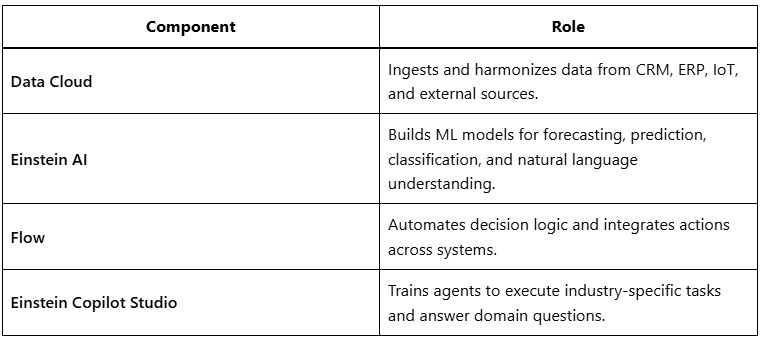How Agentforce AI Agents Transform Energy & Utilities

Introduction: Agentforce AI Agents Transform Energy & Utilities
The global energy and utilities sector is undergoing a profound transformation driven by decarbonization, decentralization, and digitalization. As governments push for net-zero emissions, consumers demand smarter services, and infrastructure ages, the industry is challenged to innovate at scale. Amid this evolution, Agentforce AI agents, powered by Salesforce and Einstein AI, are emerging as crucial allies, bringing automation, intelligence, and responsiveness to every layer of the energy value chain.
This blog explores in depth how Agentforce AI agents are revolutionizing energy and utilities, backed by practical examples, use cases, and future-forward thinking.
Table of Contents
1. What Are Agentforce AI Agents?
Agentforce AI agents are AI-powered, domain-specific virtual agents built using Salesforce’s Einstein 1 Platform, Flow automation, and Data Cloud. They blend conversational AI with enterprise logic and connect with CRMs, sensors, IoT platforms, and legacy systems.
Key characteristics:
- Context-aware: Understand customer needs based on historical and real-time data.
- Autonomous: Make decisions, take actions, and escalate as needed.
- Multichannel: Work across web, mobile, Slack, WhatsApp, IVR, and more.
- Trainable: Learn industry terminology and processes.
- Integrated: Natively connect with Salesforce Energy & Utilities Cloud, Field Service, and MuleSoft APIs.
2. Why Energy & Utilities Need AI Agents
The traditional operating models of utilities are under stress due to:
- Rising consumer expectations for instant, transparent service.
- Increased grid complexity due to distributed energy resources (DERs) like solar panels, batteries, and EVs.
- Climate change prompting extreme weather events, outages, and emergency response needs.
- Aging infrastructure needing predictive maintenance.
- Regulatory pressure for sustainability and reporting.
Manual processes, siloed systems, and legacy IT stacks hinder agility. That’s where AI agents step in to bring intelligence, speed, and scale.
3. Use Cases of Agentforce AI Agents in Energy & Utilities
Let’s dive into practical areas where Agentforce AI agents are making a difference.
a) Customer Service Transformation
Problem: Long call wait times, repetitive queries, and disconnected service channels.
Solution with Agentforce AI Agents:
- Provide 24/7 multilingual support for common questions (billing, outage status, new connections).
- Proactively notify users of outages, restoration times, and payment dues.
- Escalate to human agents via live chat if needed.
- Use voice agents in IVR systems for a conversational experience.
Impact:
- 40% reduction in call volumes.
- 60% faster resolution times.
- Improved CSAT and NPS scores.
b) Field Service & Maintenance Optimization
Problem: High operational costs, inefficient dispatching, and reactive maintenance.
Solution:
AI agents sync with Salesforce Field Service to:
- Predict equipment failure using IoT + AI.
- Automatically schedule technicians.
- Suggest parts needed based on fault patterns.
- Optimize routes and reduce truck rolls.
Example: A utility company uses an AI agent to monitor transformer temperature and automatically dispatch field teams before a breakdown.
c) Smart Grid Operations
Problem: Managing grid stability with high penetration of renewables and DERs.
Solution:
- Agents ingest smart meter and SCADA data in real time.
- Detect anomalies, load imbalances, and faults.
- Issue grid commands or reroute power autonomously.
- Send predictive alerts to grid operators.
Outcome:
- Improved grid reliability.
- Faster outage identification and restoration.
- Better integration of renewables.
d) Demand Response & Load Forecasting
Problem: Balancing demand and supply in a dynamic environment.
Agent Solution:
- Predict hourly, daily, and seasonal energy demand using AI models.
- Trigger demand response programs by sending customer notifications or adjusting thermostats (with consent).
- Automatically manage B2B contracts for demand-side flexibility.
e) Sustainability & Compliance Reporting
Problem: Manual tracking of carbon emissions and ESG data is time-consuming.
AgentForce Advantage:
- Track carbon emissions in real-time using data from connected assets.
- Automate regulatory reporting and sustainability dashboards.
- Provide sustainability scores and recommendations for improvement.
f) Renewable Energy Asset Management
Problem: Managing distributed solar, wind, and battery systems efficiently.
Agent Solutions:
- Predict energy yield based on weather and historical data.
- Identify underperforming assets.
- Schedule maintenance or panel cleaning.
- Suggest optimal times for energy storage or dispatch.
4. How Agentforce Agents Work Behind the Scenes
Agentforce leverages Salesforce Data Cloud, Einstein 1 Studio, and Flow Orchestration to power these intelligent agents.
Key Components:

Agents also use MuleSoft APIs to connect with legacy billing systems, GIS platforms, and third-party tools.
5. Industry Examples
1. PG&E (Pacific Gas and Electric)
Uses Agentforce AI agents to:
- Alert customers of Public Safety Power Shutoffs (PSPS).
- Automate grid analytics during wildfire seasons.
- Coordinate emergency field teams via AI-driven workflows.
2. National Grid UK
Leverages agents to:
- Interact with residential customers installing rooftop solar.
- Track decarbonization progress.
- Manage EV charging infrastructure planning.
3. EDF Energy
Deploys AI agents for:
- Billing resolution with generative responses.
- Emission tracking at the customer and corporate levels.
- Renewable energy performance forecasting.
6. Business Benefits of Agentforce AI in Utilities

7. Building and Deploying Your First Utility AI Agent
Step-by-step:
- Identify Use Case: Start with high-volume or high-impact scenarios (e.g., outage management).
- Ingest Data: Use Salesforce Data Cloud to integrate IoT, CRM, meter data, etc.
- Design Flows: Use Flow Builder to define agent logic and workflows.
- Train Agent: Use Copilot Studio with energy-specific intents and terminologies.
- Test: Simulate edge cases, fallback paths, and escalations.
- Deploy: Publish on Slack, web portal, WhatsApp, or mobile apps.
- Optimize: Measure outcomes and retrain the agent as needed.
8. The Future of Agentforce in Energy & Utilities
Looking ahead, we expect Agentforce agents to:
- Orchestrate entire virtual power plants (VPPs).
- Coordinate between prosumers (producer + consumer) in a transactive energy grid.
- Automate climate resilience plans, such as load shedding or evacuation alerts.
- Enable AI copilots for utility workers, offering real-time guidance during maintenance or inspections.
Generative AI will enhance these agents further by summarizing regulations, generating energy efficiency tips, or crafting customer emails all contextually and instantly.
Conclusion: AI-Powered Utilities Are Here
Agentforce AI agents represent a leap forward in how energy and utility companies operate. From improving customer satisfaction to enabling grid intelligence and sustainability, these agents are not just automating tasks they’re redefining utility operations. As we accelerate toward a net-zero, digital-first future, utilities that embrace AI agents now will lead the industry in resilience, efficiency, and innovation.

